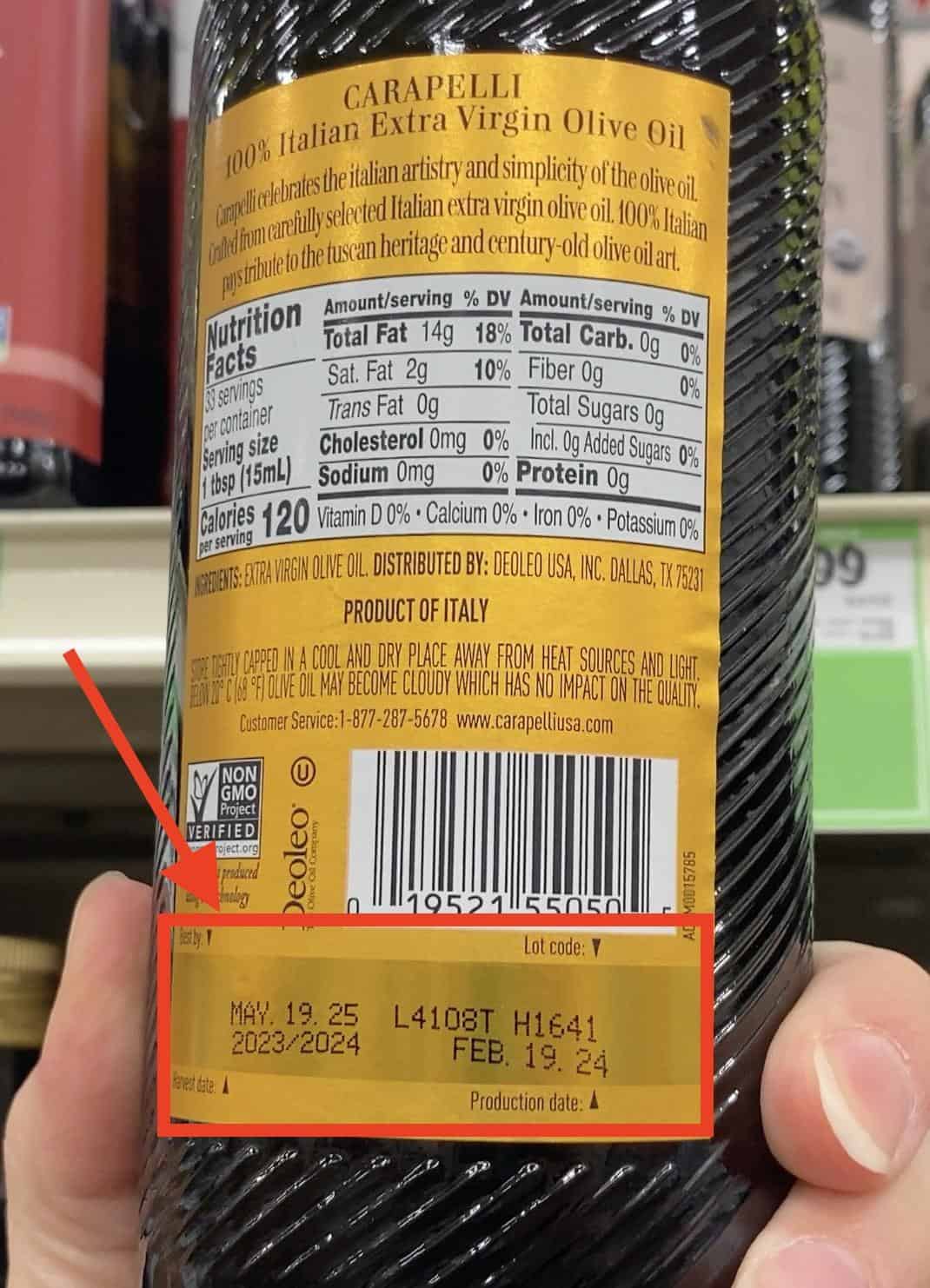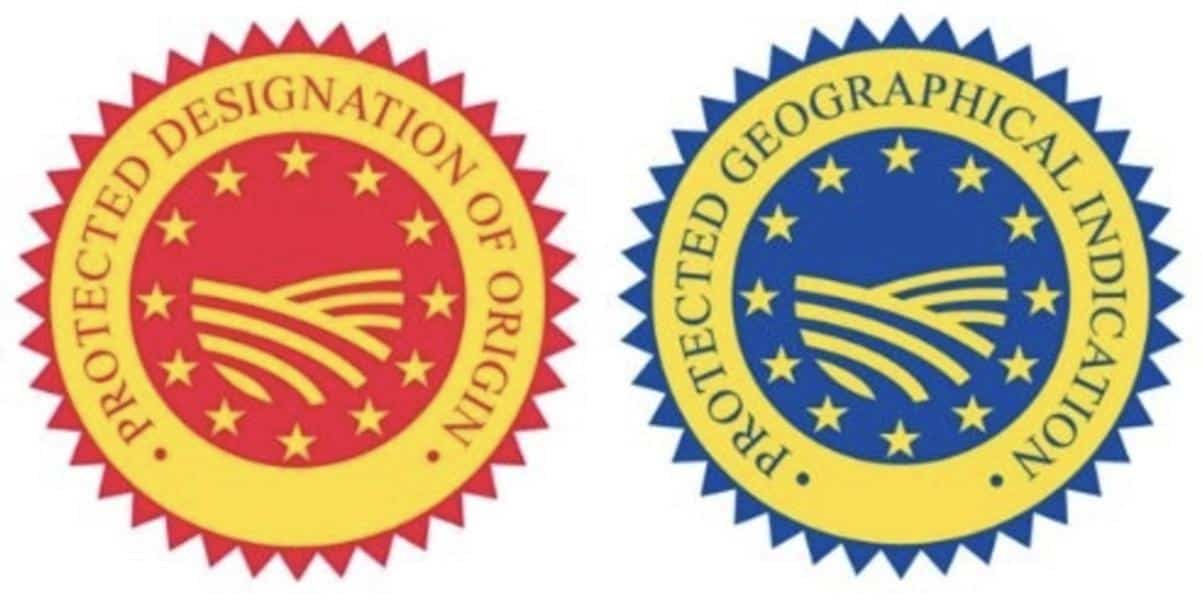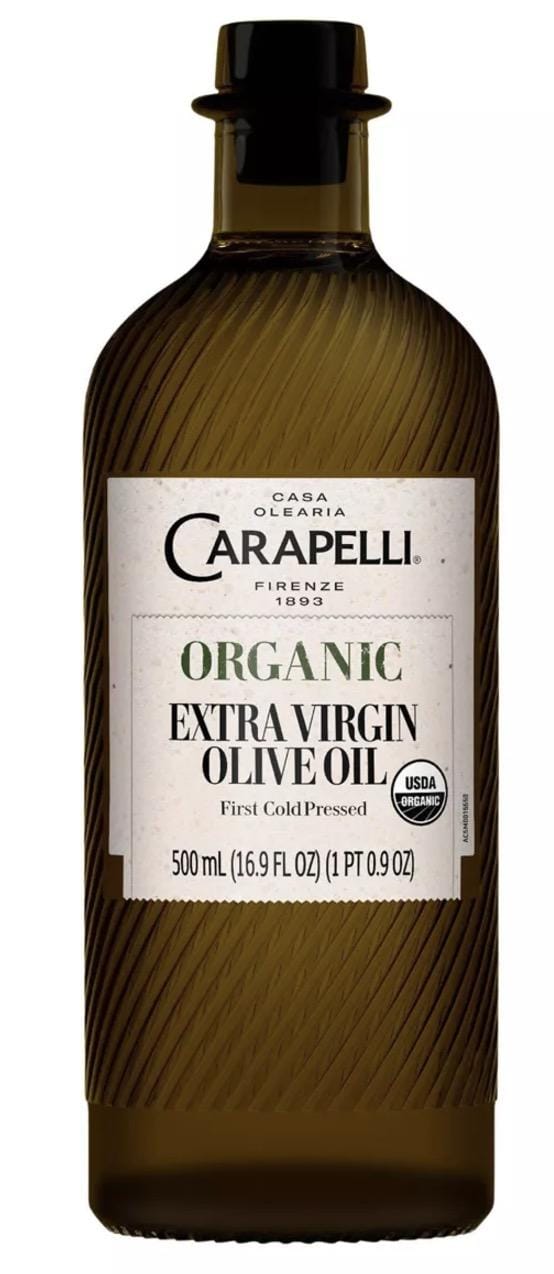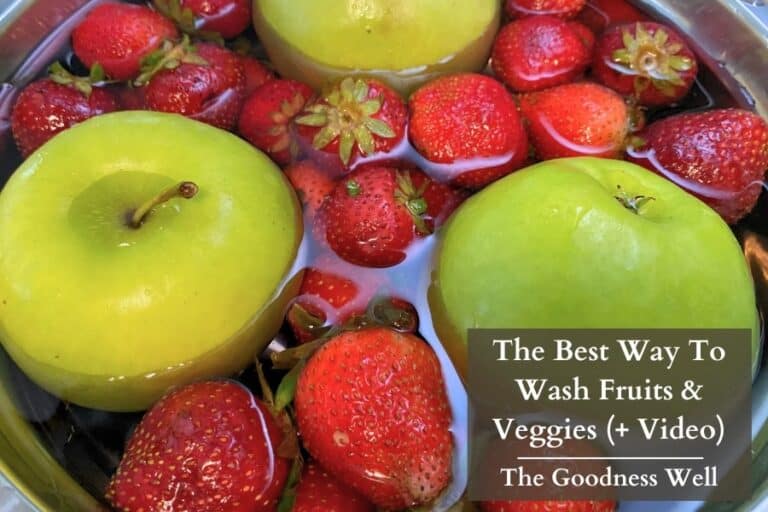How to Buy Real Olive Oil (& Spot Fake Ones)

Even though you buy “extra-virgin” olive oil on a weekly basis and cook almost every meal with it, did you know you probably have never actually tasted genuine extra-virgin olive oil?
This is because most olive oils on the shelves are not true extra virgin olive oil. They are essentially cheap knock-offs.
According to a study by the University of California-Davis, most olive oil sold in the U.S., around 69%, fails to meet the criteria for extra virgin quality.
But fortunately, once you know what to look for, it becomes pretty easy to spot the good stuff.
In this guide, we’ll show you exactly how to identify authentic olive oil and steer clear of the fakers.
We even have a list of the exact olive oils to buy and which to avoid!
Here we go!
We are reader-supported. So some links in this post may be affiliate links, which means we may earn a small commission if you make a purchase. Learn more
Why It’s Hard to Find Real Olive Oil
I know you see all those fancy-looking bottles in the grocery stores that have claims like “packaged in Italy” and think you’re getting the real deal—but the truth is, many of these labels are misleading you on purpose.
Why?
To sell cheap olives that seem high quality all in the name of more $$.
Not cool, I know.
Many of these same labelings used that can often mislead people include:
- Packaged in [Country] or Imported from [Country]
- Pure Olive Oil
- Light Olive Oil
- First Cold Pressed
- 100% Olive Oil
- All-Natural or Natural
- Rich in Antioxidants
- Mediterranean Blend
- Farm Fresh
- Premium or Gourmet
- Blended with Extra Virgin Olive Oil
Just because it says “Italy” doesn’t mean the olives were grown, harvested, or even processed there.
In fact, many of these oils are blends of lower-quality olives from multiple countries, shipped to Italy for packaging, and then labeled in a way that makes them seem authentic.
Why Choosing The Real Stuff Is Worth It
This deception is not only ripping you off financially but also robbing you of the amazing benefits real extra virgin olive oil has to offer, such as:
- Powerful antioxidants
- Anti-inflammatory properties
- High levels of heart-healthy monounsaturated fats
- Improved brain health and cognitive function
- Support for healthy cholesterol levels
- Protection against oxidative stress
- Potential cancer-fighting properties
- Enhanced skin health and anti-aging benefits
- Support for digestive health
- Better nutrient absorption when paired with certain foods
- Rich, authentic flavor that elevates your meals
When olive oil is made from very low-quality olives, like most on the shelves at stores, these benefits are significantly reduced or even completely lost due to processing, refining, and oxidation.
But now let’s look at how to spot the real stuff, so you can get on with sauteeing those veggies from now on in some truly high-quality extra-virgin olive oil.
Choosing High-Quality Olive Oil: The Seven Essentials
1. Price

High-quality olive oil just costs more. As the old saying goes, “You get what you pay for”.
Avoid the bargain brands.
Typical Cost of Extra Virgin Olive Oil:
- Top Tier: $15–$30 per 500 mL bottle
- Mid-Tier: $10-$15 per 500 mL bottle
- Low Quality: Less than $10 per 500mL bottle
*Keep in mind prices can vary based on location or store but this is a common range of prices.
2. Packaging
Olive oil can degrade when exposed to light for extended periods, so look for dark glass bottles to prevent oxidation and avoid plastic leaching harmful chemicals into your oil.


3. Harvest Date
A harvest date on an olive oil bottle is the specific time period when the olives used to make the oil were harvested from the trees.

Harvest dates should be found somewhere near the bottom of the bottle, usually on the back.
If the bottle has no harvest date, it is low-quality olive oil.
Aim for a harvest date within the last 1–2 years.
4. Single-Origin Source
You will find the country of origin on olive oil bottles, usually near the harvest date. It often includes abbreviations like:
- IT for Italy
- GR for Greece
- ES for Spain
- TN for Tunisia
- PT for Portugal
- US for the United States
Most of the time, you will see multiple of these abbreviations on a bottle, which indicates it is sourced from multiple countries.
This can lead to inconsistent olive oil quality as many times quality olives are mixed with low-quality olives.
Also, it gives the manufacturer the ability to claim things like “sourced in Italy”, which gives many people the impression that the olive oil is high quality.

For example, this bottle is made from olives sourced from Spain & Italy.
While one single source is ideal, the fewer sources the better.
Olives from a single region or country ensure better quality because they’re grown, harvested, and processed under consistent conditions, which preserves freshness, flavor, and nutrients.
This also reduces the risk of mixing with lower-quality oils and allows for better traceability and authenticity.


“This exclusive fresh EVOO is made with 100% organic olives grown in Tuscany, Italy.”
These organic olives were grown exclusively in Tuscany, Italy.
One Source.
This olive oil is the best of the best.
Bottles with olives grown in one place usually make it clear right on the label, instead of using small abbreviations like other bottles.
If the olives come from a single location, the company wants you to know, so they don’t hide it in tiny print at the bottom.
This bottle, for example, states this specifically on the back of the bottle.
5. Certifications
Key certifications to look for: USDA Organic, NAOOA Seal, PGI, PDO, etc.
Statements That Don’t Guarantee Quality ❌
- ISO Certification: Ensures the company meets international production standards but doesn’t guarantee the oil’s quality.
- “First Cold Pressed”: Describes the method used but doesn’t indicate the oil’s quality or authenticity.
- “100% Pure Olive Oil”: Marketing term; doesn’t guarantee it’s extra virgin or high quality.
Certifications That Guarantee Better Olive Oil
- North American Olive Oil Association (NAOOA) Seal: Confirms the oil meets chemical and sensory standards for extra virgin olive oil.
- USDA Organic: Indicates the olives were grown without synthetic pesticides or fertilizers. Better for the environment and your health
- California Olive Oil Council (COOC) Seal: Ensures the oil is certified as genuine extra virgin and made in California.

Certifications That Guarantee High-Quality Extra Virgin Olive Oil ✅
- Protected Designation of Origin (PDO): The oil is fully made—grown, processed, and packaged—in a specific region. This is the the best certification to ensure high-quality olive oil.
- Protected Geographical Indication (PGI): The oil is linked to a specific region, but only one part of the process (like growing or packaging) must happen there, making it a slightly lower standard than PDO, but still ensures high quality.

6. Traceability
This isn’t a hard rule, but high-quality olives oils can sometimes have a QR code you can scan to see detailed information about the oil’s origin, production process, and certifications.
QR codes and labels that allow you to trace the oil’s origin are good indicators of authenticity.
7. Organic

Organic olive oil is a good indicator of quality in olive oil, but being organic alone doesn’t guarantee it’s high quality.
Some organic olive oils can still be made from low-quality olives.
Many quality olive oil brands may meet some of this criteria but not all. To ensure you’re getting a truly high-quality bottle, focus on the most important factors:
- Packaging (dark glass)
- Harvest date within the last 1–2 years
- Single or fewest-source origin
- Recognized certifications like PDO, PGI or USDA Organic
- Price range that reflects quality ($15–$30 per 500mL).

A true quality bottle will meet ALL of these criteria
The Best Olive Oils (Ranked)
This list is based on olive oils that can be found at most major grocery stores. Check your local stores for availability.
I recommend getting your olive oil online as it is rare that grocery stores carry authentic extra virgin olive oil.
True Extra Virgin Olive Oil
1. Belluci Toscano Pgi Organic Extra Virgin Olive Oil

- ✅ Dark Glass Bottle
- ✅ Harvest Date Within the Last 1–2 Years
- ✅ Single-Region or Single-Country Origin
- ✅ Price Range: $15–$30 per 500mL/16.9oz
- ✅ Origin Info or QR Code for Traceability
- ✅ Good-Quality Certifications
- ✅ USDA Organic
- NAOOA Seal
- ✅ High-Quality Certifications
- ✅ PDO (Protected Designation of Origin)
- PGI (Protected Geographical Indication)
Found at: Whole Foods, some Alberstons, and Amazon
2. Extra Virgin Olive Oil Sicilian Pgi Organic

- ✅ Dark Glass Bottle
- ✅ Harvest Date Within the Last 1–2 Years
- ✅ Single-Region or Single-Country Origin
- ✅ Price Range: $15–$30 per 500mL/16.9oz
- ✅ Origin Info or QR Code for Traceability
- ✅ Good-Quality Certifications
- ✅ USDA Organic
- NAOOA Seal
- ✅ High-Quality Certifications
- PDO (Protected Designation of Origin)
- ✅ PGI (Protected Geographical Indication)
Found at: Whole Foods or Amazon
Mid-Tier Olive Oils
3. California Olive Ranch 100% California Medium Extra Virgin Olive Oil

- ✅ Dark Glass Bottle
- ✅ Harvest Date Within the Last 1–2 Years
- ✅ Single-Region or Single-Country Origin
- ✅ Price Range: $15–$30 per 500mL/16.9oz
- ✅ Origin Info or QR Code for Traceability
- ❌ Good-Quality Certifications
- USDA Organic
- NAOOA Seal
- ❌ High-Quality Certifications
- PDO (Protected Designation of Origin)
- PGI (Protected Geographical Indication)
Found at: Most major grocery stores or Amazon
4. Terra Delyssa Organic Extra Virgin Olive Oil

- ✅ Dark Glass Bottle
- ✅ Harvest Date Within the Last 1–2 Years
- ❌ Single-Region or Single-Country Origin
- ❌ Price Range: $15–$30 per 500mL/16.9oz
- ✅ Origin Info or QR Code for Traceability
- ✅ Good-Quality Certifications
- USDA Organic
- NAOOA Seal
- ❌ High-Quality Certifications
- PDO (Protected Designation of Origin)
- PGI (Protected Geographical Indication)
Found at: Most major grocery stores
5. Carapelli 100% Organic Extra Virgin Olive Oil
This olive oil is a borderline example of quality—it’s organic and packaged in a dark glass bottle, which are good signs, but it lacks other key criteria to confirm it’s truly high quality.
This is the lowest standard I would consider somewhat acceptable.

- ✅ Dark Glass Bottle
- ❌ Harvest Date Within the Last 1–2 Years
- ❌ Single-Region or Single-Country Origin
- ❌ Price Range: $15–$30 per 500mL/16.9oz
- ❌ Origin Info or QR Code for Traceability
- ✅ Good-Quality Certifications
- ✅ USDA Organic
- NAOOA Seal
- ❌ High-Quality Certifications
- PDO (Protected Designation of Origin)
- PGI (Protected Geographical Indication)
Found at: Most major grocery stores
Low-Quality Olive Oils
As discussed, most olive oils at grocery stores are very low quality and not true extra virgin olive oil.
Here are some olive oil brands to avoid when shopping:
Pompeian USDA Organic Smooth Extra Virgin Olive Oil

Remember, just because it’s organic, doesn’t mean it’s quality.
- ❌ Dark Glass Bottle
- ❌ Harvest Date Within the Last 1–2 Years
- ❌ Single-Region or Single-Country Origin
- ❌ Price Range: $15–$30 per 500mL/16.9oz
- ❌ Origin Info or QR Code for Traceability
- ✅ Good-Quality Certifications
- ✅ USDA Organic
- NAOOA Seal
- ❌ High-Quality Certifications
- PDO (Protected Designation of Origin)
- PGI (Protected Geographical Indication)
Extra Virgin Olive Oil – Good & Gather

Meets no quality markers ❌
- ❌ Dark Glass Bottle
- ❌ Harvest Date Within the Last 1–2 Years
- ❌ Single-Region or Single-Country Origin
- ❌ Price Range: $15–$30 per 500mL/16.9oz
- ❌ Origin Info or QR Code for Traceability
- ❌Good-Quality Certifications
- USDA Organic
- NAOOA Seal
- ❌ High-Quality Certifications
- PDO (Protected Designation of Origin)
- PGI (Protected Geographical Indication)
Bertolli Extra Virgin Olive Oil

Meets no quality markers ❌
- ❌ Dark Glass Bottle
- ❌ Harvest Date Within the Last 1–2 Years
- ❌ Single-Region or Single-Country Origin
- ❌ Price Range: $15–$30 per 500mL/16.9oz
- ❌ Origin Info or QR Code for Traceability
- ❌Good-Quality Certifications
- USDA Organic
- NAOOA Seal
- ❌ High-Quality Certifications
- PDO (Protected Designation of Origin)
- PGI (Protected Geographical Indication)
Great Value: 100% “Extra Virgin Olive Oil“

Meets no quality markers ❌
- ❌ Dark Glass Bottle
- ❌ Harvest Date Within the Last 1–2 Years
- ❌ Single-Region or Single-Country Origin
- ❌ Price Range: $15–$30 per 500mL/16.9oz
- ❌ Origin Info or QR Code for Traceability
- ❌Good-Quality Certifications
- USDA Organic
- NAOOA Seal
- ❌ High-Quality Certifications
- PDO (Protected Designation of Origin)
- PGI (Protected Geographical Indication)






